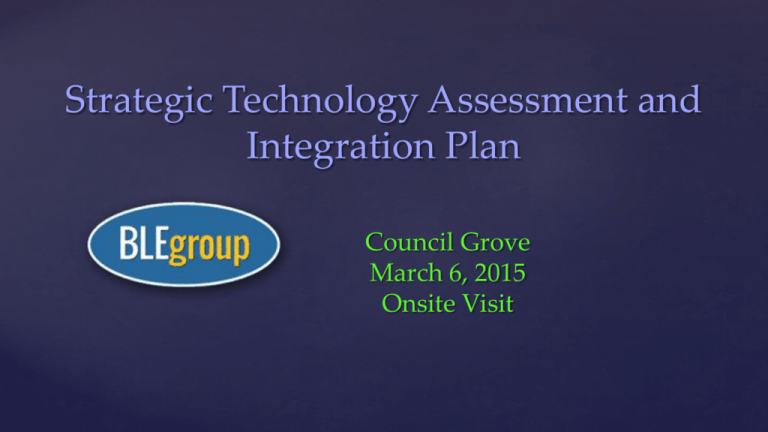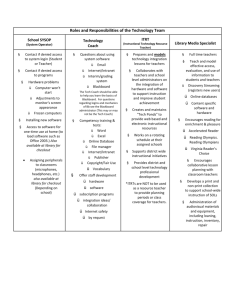Strategic Technology Assessment and Integration Plan
advertisement

Strategic Technology Assessment and
Integration Plan
{
Council Grove
March 6, 2015
Onsite Visit
Urgency for Change
The changing landscape of the world’s information
to digital form will require today’s student to have a
different set of skills than what was required just a
decade ago. Future graduates must be equipped
with not just the three R’s, but also with 21st century
skills of problem solving, critical thinking,
communication, and technological literacy.
Students will need to be able to quickly find,
synthesize and communicate information and
collaborate with colleagues--not just in their own
office, but within a global community of colleagues
and customers.
Moving from Vision to Action
Creating a Technology Vision
1
Develop District Technology Goals
linked to Strategic Plan
2
Develop Action Plans
3
Create Monthly Timelines
4
Anticipate Ongoing Change
Action Plan Items
Summary of Current State
● District leadership and board ready to move to digital era
●
Budget issues
●
Staffing questions
● Noticeable optimism of continuous improvement under Superintendent
Conwell’s leadership
● Variety of instructional programs and mix of autonomy and central decision
making
● District is generally performing at or above other districts in state testing mandates
● Shrinking school populations
● Varying levels of technology use and adoption/acceptance among staff in
grades/subject areas
Summary of Current State
● Insufficient bandwidth in schools
● Limited professional development for technology/curriculum integration
● District and school websites provide communication to the community,
however teacher websites are lacking
● Partial or non-existent data integration between systems
● Technology use remains teacher centric with some exceptions
● Significant student recognition of the power of and need for technology
Areas Ripe for Improvement
●
Network response time
●
Professional development (tech skills needs assessment for all staff – certified and support)
(Individualized training, online training, just in time (step-by-step)/job embedded...)
●
Staff and student secure logins are necessary
●
Lack of robust/reliable infrastructure and resources impedes interest in moving forward
with innovation
●
Wireless capacity needs expansion
●
Uniform minimum classroom technology standards
●
Need tech support ticketing system (data lacking)
●
Lack of just in time classroom technology support/coaching
●
Lack of enterprise-wide data architecture
●
Fulltime technology leader with skills in instructional and network technology (Technology
Director)
What is working…
●
Leadership and board recognized the opportunity to build a 21st century school
district.
●
The technology support teachers are knowledgeable, helpful and well respected.
●
PowerSchool system training has worked.
●
Many new teachers are coming in with tech awareness and skills.
●
Mobile carts are well utilized.
●
“iPads work well, but for real work, give me a laptop”
●
Acquring laptop and desktop machines – aiming for 1-1
●
Can access files from home and anywhere on campus. (Google drive)
●
Needed Policies
Adopt a plan of obsolescence with standardized life-cycle for hardware and management
systems
●
Incentives for teachers to gain and properly utilize technology to advance student learning
●
Institute technology competencies for teachers, students, administrators and support staff
●
Terms of service agreements for equipment
●
Need curriculum for technology fluency and digital literacy
●
Need teacher performance expectations for classroom technology integration
●
Modify, formalize and expand technology committee composition and roles
●
Create process to vet proposed materials
●
Integrated data management systems use and interoperability
●
Updated district and school technology plans
●
Adopt efficiency measures to free up funding for technology leadership and tech support
Instruction
Instruction - Current State
● Principals focused on programs with autonomy
●
●
Managed inconsistency
●
3 types of devices, 3 operating systems
●
Mixed school/district curriculum control
●
No formal policy for replacement cycle
Not defined instructional technology framework
● Varied engagement of instructional technology within classrooms
● Some libraries function as media centers
● Mobile carts are fully utilized
Instruction - Current State
● Varied data driven decision making central office/classroom
● Some digital curriculum on iPads
● No learning management system/adaptive platform for delivering
digital materials
● Alignment of technology to curriculum is being discussed
● No technology curriculum and competency framework for teachers and
students is in place
Instruction - Dashboard
Low
Average
High
Instruction - Target State
● Classroom instruction should shift to a learner centric model where
technology supports, individualizes and extends learning
opportunities
● Minimize teacher management processes
● Focus on student data driven decisions and individualized
instruction
● Move towards 1:1 computing for personalized learning
● All instructional materials digital and linked to appropriate
standards
Instruction - Target State
● Adaptive assessment and adaptive instruction should drive
personalized learning
● Sharing of effective programs and best practices between schools
● Graduates required to demonstrate:
● Learning in context, critical thinking skills, use of technology for
finding/analyzing information and producing presentations
● Increase fluency with non-text materials
● Clear understanding of tech integration expectations and
measures (NETS – S, T & A)
Instruction - Target State
● Consolidation of schools maximizing resources and course
offerings - virtual courses part of day
● Increased use of analytic tools
● Walk through processes for teachers, principals, and
support personnel
● Process to vet recommended and approved materials
Instruction - Target State
● Robust repository for digital materials
● Standards-based best practices shared in repository
● Collaborative Learning Management System (LMS) is used by all
teachers and students
● Use of interdisciplinary activities between content areas
● Adoption of standards for technology integration (NETS) and tied to
principal walk throughs (instructional rounds)
● Cost of materials and devices will not cost more than current
materials
Technology Infrastructure
Technology Infrastructure - Current State
● Minimal and varied backup procedures are in place
●
Disaster recovery/business continuity plan should be formalized (privacy issues)
●
School infrastructure, WAN and WIFI capacity need to be increased
● Wireless currently inadequate and unreliable
●
●
Expansion being is being discussed
There is an issue with IP addresses
● No formal/standardized device life cycle
●
●
Some obsolescent technology being used for students
Use of “group” printers seems inefficient
Technology Infrastructure - Current State
● Technology procedures and policies are not in place to support the
21st century classroom
● Not enough student devices for online testing model or full student
use in all schools
● No full time staff responsible for infrastructure and support
Technology Infrastructure - Dashboard
Low
Avg
High
Technology Infrastructure - Target State
● Ubiquitous high density wireless
● Increased access to devices for students (1-1 is suggested)
●
Begin pilots for 1:1 devices
● Define clear procedures for adopting/exploring new technologies
● Build infrastructure to consistently support multiple services (i.e. video,
voice, surveillance)
● Mounted projectors for safety and ease of use
●
Students and parents have ready access to digital content 24/7
Technology Infrastructure - Target State
● Secure, individual log-ons
● Bring your own device district wide
● Secure and defined data security procedures and policies
● Clear, defineable assistive technology plan
Infrastructure Target - Wireless
Management Systems
Management Systems - Current State
● Student Information System (PowerSchool) adequate
● No apparent data analytics system
● No comprehensive data warehouse
● Potential lack of strategic data integration
● Many discrete management systems in silos
● Partial or non-existent data integration between systems
Management Systems- Dashboard
Domains
1
Low
Learning Management System
NA
Curriculum Management System
NA
Student Information System
ERP (HR/PR/FI) Systems
Special Education System (unknown)
Transportation System (unknown)
Food Services System
Parent Portal
Data Warehouse and Analytics
2
3
Avg
4
5
High
Management Systems - Target State
● Increase interoperability and data sharing between all systems
●
Implement data workflow plan that outlines data to be shared between systems
●
Implement a data architecture with backups that minimizes dependencies
● Adopt learning management system platform
● Adopt and establish uniform standards for website content creation and
communication
● Establish review process and adoption procedures for management
systems that include all stakeholders
Management Systems - Target State
● Make widely available professional development, documentation, and
support for all management systems
● Efficiencies and improved district communication could be accomplished
with a sophisticated, formal web and social media plan/strategy
● Conduct a thorough review of stakeholder reporting needs
●
Rich data insight at all levels
● Implement a data warehouse and/or define analytic tools
Technology Organization
Technology Organization - Current State
● Part-time staff is well respected, but ability to provide comprehensive
support is extremely limited.
● School based tech support is knowledgeable but task-limited due to
other full time responsibilities.
● Priorities are determined opportunistically
●
Triage often drives decisions
● No integrated technology roadmap guides the organization
● General focus is reactive not proactive
●
Autonomy at the site level has sometimes created a lack of coordination
Technology Organization - Current State
● Current part-time and school based tech support staff are over taxed
● Contracted IT staff provides an approach to plans and issues on a just-intime basis
Common Themes:
● Focus on outside support, asset management not consistent nor thorough
● Principals have site autonomy
● No comprehensive infrastructure plan
● No full time IT staff creates demands and impacts instructional time
Technology Organization - Dashboard
Domains
1
Technical Support/”Break-Fix”
Low
Network Management Support
Instructional Technology Support at District Level
Instructional Technology Support at Building Level
Help Desk Operations (does not exist)
Applications Support
Reporting Structure and Roles
Staff (Faculty) Tech Competency Levels (unknown)
2
3
Avg
4
5
High
Technology Organization - Target State
● Schools- Teacher coaches
become building based
instructional technology coaches
● Provides feedback and support
for teachers as well as
walkthrough
Technology Organization - Target State
● Establish district technology leadership position
●
Responsible for technology vision, thought leadership, change agency, and evangelism
●
Responsible for technology strategy and long term plan
●
Oversees instructional technology
●
Oversees infrastructure
●
Service level agreements – coordinate technology plan with each school
● This position should have a direct relationship to curriculum leaders with a
shared responsibility to:
●
Run training programs
●
Oversee technology curriculum selection
●
Identify and coordinate digital curriculum
●
Supervise building level instructional support (coaches/technology)
Technology Organization - Target State
● Create formal Help Desk system for all support issues
● Use data to drive decisions and plan use of resources
● Develop a strategic technology and learning plan that
provides the blueprint to create a community foundation to
provide added technology resources (funding)
● Seek system and structural efficiencies to provide diverse
funding shifts
Getting to the Target Environment in 2016
Implementation Timeline
3 months
Instruction
Infrastructure
Get formal reviews
regarding audit from
a.
School board
b. Principals
c.
Committee
d. Parents
e.
Tech staff
f.
Curriculum staff
Reorganize the
technology committee.
Committee and principals
visit quality school
districts who have a
record of success Ed Tech
Management
Systems
Organization
Improve building level
Wi-Fi access and
infrastructure
Research LMS/ adaptive
instruction system (PD)
Begin development of
district wide tech
policies
Improve WAN/Network
upgrades
Discuss web strategy/
communication plan for
enhanced
communication with
community and staff
Create district tech
leadership position
Discuss feasibility of 1-1
pilot
Survey staff as to
ideal professional
development needs
and offerings.
Appendix
Managing Complex Change
Creating the
Conditions for
Effective
Professional
Development
Measurement
of
Instructional
Technology
SAMR Model
Useful Links for Further Research
● Exemplary Tech Savvy School Districts
● High Tech High (charter K-12 school District + Grad. School)
●
http://www.hightechhigh.org
● Kent School District
●
http://www.kent.k12.wa.us/site/default.aspx?PageID=1
● Classroom Technology Integration Rubrics
●
http://application.jff.org/userImages/files/technology_integration_rubricnew-1-3.pdf
●
http://www.ascd.org/ASCD/pdf/journals/ed_lead/el201303_johnson_rubric.pdf





